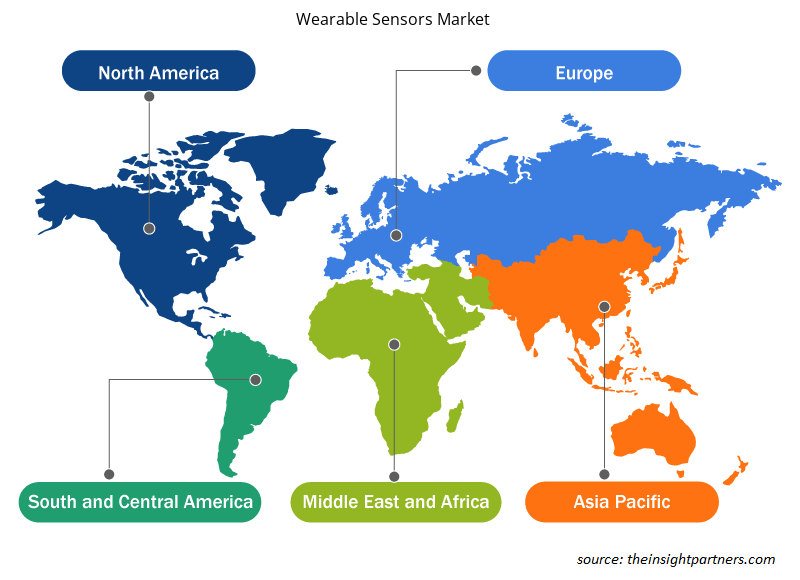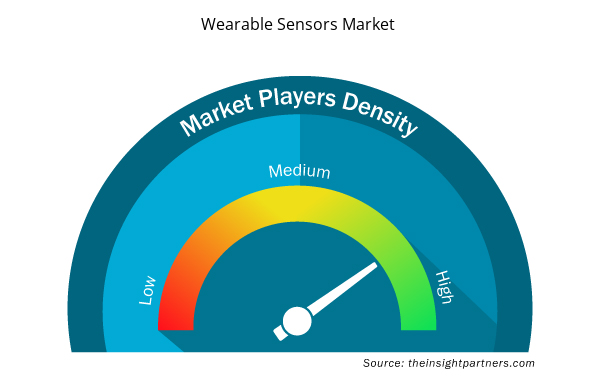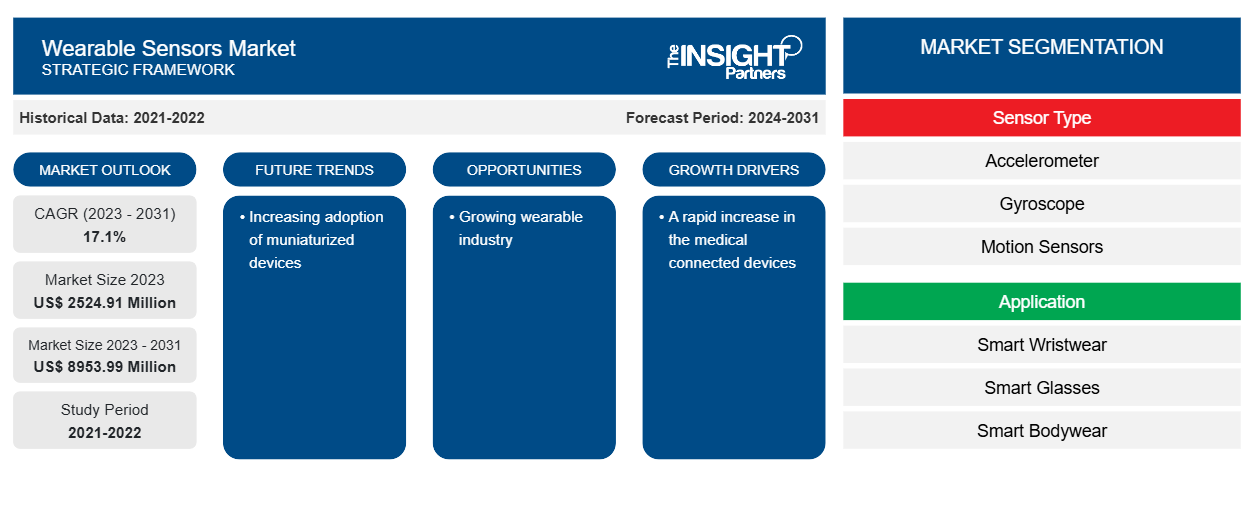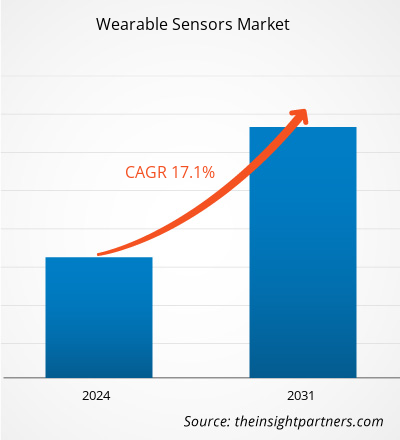ウェアラブルセンサーの市場規模は、2023年の25億2,491万米ドルから2031年には89億5,399万米ドルに達すると予測されています。市場は2023年から2031年の間に17.1%のCAGRを記録すると予想されています。小型デバイスの採用増加は、引き続き市場の重要なトレンドとなると思われます。
ウェアラブルセンサー市場分析
コネクテッドデバイスやスマートフォンの利用が急増し、性能が向上した低電力、軽量、小型のセンサーに対するニーズが高まっていることが、小型化のトレンドを確立する要因となっています。微細加工とナノテクノロジー 技術の進歩により、小型化プロセスが加速し、スマートファブリックの出現が定着し、スマートセンサーのコスト効率が向上しています。将来的には、アボットラボラトリーズが 2022年1月にグルコースモニタリングシステムであるLibre 3システムを披露しました。このように、ウェアラブルデバイスの需要の高まりが、世界のウェアラブルセンサー市場を牽引しています。
ウェアラブルセンサー市場の概要
ウェアラブルセンサーとは、個人のヘルスケアを目的として、人の皮膚や衣服に直接貼り付けて生体信号を収集するセンサーです。MNPの柔軟な薄膜を適切な基板上に堆積し、温度や圧力を制御して健康信号として利用します。IoT(Internet of Things)技術の導入により、あらゆるものがインターネットにつながるようになり、ウェアラブルデバイスからデータを収集し、人工知能(AI)で解析する仕組みづくりが進んでいます。すでにアイウェア、腕時計、リストバンドなどのウェアラブルデバイスはありますが、最近ではシャツなど毎日着用できるものや、薄膜やエラストマーなどを用いた高感度、多機能、軽量のフレキシブルデバイスの開発が進んでいます。
要件に合わせてレポートをカスタマイズする
このレポートの一部、国レベルの分析、Excelデータパックなど、あらゆるレポートを無料でカスタマイズできます。また、スタートアップや大学向けのお得なオファーや割引もご利用いただけます。
- このレポートの主要な市場動向を入手してください。この無料サンプルには、市場動向から見積もりや予測に至るまでのデータ分析が含まれます。
ウェアラブルセンサー市場の推進要因と機会
医療関連機器の急増
デジタルヘルスケアは、ヘルスケアとテクノロジーをつなぐ概念を含む広範な概念です。患者を遠隔で監視する場合、接続された医療機器は重要な要素です。これらの機器は、患者と医療提供者を医療情報でシームレスに接続することで、ヘルスケア業界を真に変革しています。ここ10年ほど、技術の進歩により、患者と医療提供者がコミュニケーションギャップを縮めることができるデジタルヘルスケア機器が登場してきました。接続されたBPなどのスマートフォンアプリは、酸素レベルを監視し、重要なデータを追跡して生成します。接続された機器のほとんどには、リアルタイム監視や高解像度 画像など、さまざまな機能が備わっています。これは、患者の健康の改善に貢献します。デジタルヘルス技術により、患者は世界のどこからでもケアを受けることができます。ウェアラブルセンサーはこのような機器で広く使用されており、ウェアラブルセンサーの市場成長を後押ししています。
成長するウェアラブル産業
スマート モバイル デバイスとモノのインターネット (IoT) は、ユーザーに多くのメリットをもたらし、市場に新たな機会を生み出すため、ウェアラブルの開発を促進してきました。健康的なライフスタイルをサポートする消費者向けウェアラブルから、患者のバイタル サインを管理する医療用ウェアラブルまで、センシング コンポーネントはこれらのウェアラブル テクノロジーを実現し、ユーザーに生産性、安全感、健康促進効果をもたらします。ウェアラブル業界が成長を続けるにつれ、ウェアラブルの適切な長期機能性には、よりコンパクトで正確かつ信頼性の高いセンシング テクノロジーの必要性が高まっています。
ウェアラブルセンサー市場レポートのセグメンテーション分析
ウェアラブル センサー市場分析の導出に貢献した主要なセグメントは、センサーの種類、アプリケーション、垂直です。
- センサーの種類に基づいて、ウェアラブルセンサー市場は、加速度計、ジャイロスコープ、モーションセンサー、画像センサー、圧力および力センサー、タッチセンサー、位置センサー、その他に分類されます。カスタマイズされたセグメントは、2023年に大きな市場シェアを占めました。
- 用途別に見ると、市場はスマートリストウェア、スマートグラス、スマートボディウェア、スマートフットウェアなどに分類されます。
- 垂直別に見ると、市場は民生用電子機器、ヘルスケア、産業およびエンタープライズに分類されます。
ウェアラブルセンサーの地域別市場シェア分析
ウェアラブル センサー市場レポートの地理的範囲は、主に北米、アジア太平洋、ヨーロッパ、中東およびアフリカ、南米および中米の 5 つの地域に分かれています。
ウェアラブルセンサー市場は北米が優勢です。GSM協会によると、北米のスマートフォン普及率は2021年に約81%になると予測されています。同協会はまた、約3億2,900万人がモバイルサービスに加入していると述べています。モバイルは経済に貢献し続けており、2021年にはモバイルサービスとテクノロジーが北米のGDPの4.2%を生み出しました。この高い普及率は、インターネットアクセスの普及、高度な通信インフラ、高い生活水準など、さまざまな要因に起因しています。そのため、この地域ではウェアラブルセンサーの需要が高まっています。
ウェアラブルセンサー市場の地域別分析
予測期間を通じてウェアラブル センサー市場に影響を与える地域的な傾向と要因は、Insight Partners のアナリストによって徹底的に説明されています。このセクションでは、北米、ヨーロッパ、アジア太平洋、中東、アフリカ、南米、中米にわたるウェアラブル センサー市場のセグメントと地理についても説明します。

- ウェアラブルセンサー市場の地域別データを入手
ウェアラブルセンサー市場レポートの範囲
| レポート属性 | 詳細 |
|---|---|
| 2023年の市場規模 | 25億2,491万米ドル |
| 2031年までの市場規模 | 89億5,399万米ドル |
| 世界のCAGR(2023年~2031年) | 17.1% |
| 履歴データ | 2021-2022 |
| 予測期間 | 2024-2031 |
| 対象セグメント | センサータイプ別
|
| 対象地域と国 | 北米
|
| 市場リーダーと主要企業プロフィール |
|
ウェアラブルセンサー市場のプレーヤー密度:ビジネスダイナミクスへの影響を理解する
ウェアラブル センサー市場は、消費者の嗜好の変化、技術の進歩、製品の利点に対する認識の高まりなどの要因により、エンド ユーザーの需要が高まり、急速に成長しています。需要が高まるにつれて、企業は提供内容を拡大し、消費者のニーズを満たすために革新を起こし、新たなトレンドを活用し、市場の成長をさらに促進しています。
市場プレーヤー密度とは、特定の市場または業界内で活動している企業または会社の分布を指します。これは、特定の市場スペースに、その市場規模または総市場価値に対してどれだけの競合相手 (市場プレーヤー) が存在するかを示します。
ウェアラブルセンサー市場で事業を展開している主要企業は次のとおりです。
- テキサス・インスツルメンツ株式会社
- NXPセミコンダクターズ
- アナログ・デバイセズ
- STマイクロエレクトロニクス
- インフィニオンテクノロジーズAG
- センシリオンAG
免責事項:上記の企業は、特定の順序でランク付けされていません。

- ウェアラブルセンサー市場のトップキープレーヤーの概要を入手
ウェアラブルセンサー市場のニュースと最近の動向
ウェアラブル センサー市場は、主要な企業出版物、協会データ、データベースなどの一次調査と二次調査後の定性的および定量的データを収集することによって評価されます。ウェアラブル センサー市場におけるいくつかの開発を以下に示します。
- Signify は、最近開通した Ahmed Hamdy 2 トンネルに LED 照明を設置すると発表しました。Signify は、国際規格に適合した最新の照明システムを使用して、照明のリモート制御を可能にしながら、最大 70% のエネルギー節約を実現します。(出典: Signify、プレスリリース、2021 年 10 月)
- タングスラムグループは12月にスペインの「トレスポンツトンネル」の照明工事契約を締結した。このプロジェクトは、ブダペストを拠点とする同社が2020年にスペインで受注した6件目のトンネル照明契約となり、コロナウイルスのパンデミックによる経済的困難を考慮すると大きな成果である。(出典:タングスラムグループ、プレスリリース、2022年9月)
ウェアラブルセンサー市場レポートの対象範囲と成果物
「ウェアラブルセンサー市場規模と予測(2021〜2031年)」レポートでは、以下の分野をカバーする市場の詳細な分析を提供しています。
- ウェアラブルセンサー市場の規模と予測(世界、地域、国レベルで)
- ウェアラブルセンサー市場の動向、推進要因、制約、主要な機会などの市場動向
- 詳細なPEST/ポーターの5つの力とSWOT分析
- ウェアラブルセンサー市場分析では、主要な市場動向、世界および地域の枠組み、主要プレーヤー、規制、最近の市場動向を取り上げています。
- ウェアラブルセンサー市場の市場集中、ヒートマップ分析、主要プレーヤー、最近の動向を網羅した業界展望と競争分析
- 詳細な企業プロフィール
- 過去2年間の分析、基準年、CAGRによる予測(7年間)
- PEST分析とSWOT分析
- 市場規模価値/数量 - 世界、地域、国
- 業界と競争環境
- Excel データセット



Report Coverage
Revenue forecast, Company Analysis, Industry landscape, Growth factors, and Trends

Segment Covered
This text is related
to segments covered.

Regional Scope
North America, Europe, Asia Pacific, Middle East & Africa, South & Central America

Country Scope
This text is related
to country scope.
よくある質問
North America dominates the wearable sensors market.
A rapid increase in the medical connected devices and the growing wearable industry are the major factors that propel the global wearable sensors market.
The increasing adoption of miniaturized devices is anticipated to play a significant role in the global wearable sensors market in the coming years.
The key players holding majority shares in the global wearable sensors market are Texas Instruments Incorporated, NXP Semiconductors, Analog Devices, Inc, STMicroelectronics, Infineon Technologies AG, Sensirion AG, Robert Bosch GmbH, Panasonic Corporation, TE Connectivity Corporation, and TDK Corporation.
The global wearable sensors market is expected to reach US$ 8953.99 million by 2031.
The expected CAGR of the global wearable sensors market is 17.1%.
Trends and growth analysis reports related to Electronics and Semiconductor : READ MORE..
The Insight Partners performs research in 4 major stages: Data Collection & Secondary Research, Primary Research, Data Analysis and Data Triangulation & Final Review.
- Data Collection and Secondary Research:
As a market research and consulting firm operating from a decade, we have published and advised several client across the globe. First step for any study will start with an assessment of currently available data and insights from existing reports. Further, historical and current market information is collected from Investor Presentations, Annual Reports, SEC Filings, etc., and other information related to company’s performance and market positioning are gathered from Paid Databases (Factiva, Hoovers, and Reuters) and various other publications available in public domain.
Several associations trade associates, technical forums, institutes, societies and organization are accessed to gain technical as well as market related insights through their publications such as research papers, blogs and press releases related to the studies are referred to get cues about the market. Further, white papers, journals, magazines, and other news articles published in last 3 years are scrutinized and analyzed to understand the current market trends.
- Primary Research:
The primarily interview analysis comprise of data obtained from industry participants interview and answers to survey questions gathered by in-house primary team.
For primary research, interviews are conducted with industry experts/CEOs/Marketing Managers/VPs/Subject Matter Experts from both demand and supply side to get a 360-degree view of the market. The primary team conducts several interviews based on the complexity of the markets to understand the various market trends and dynamics which makes research more credible and precise.
A typical research interview fulfils the following functions:
- Provides first-hand information on the market size, market trends, growth trends, competitive landscape, and outlook
- Validates and strengthens in-house secondary research findings
- Develops the analysis team’s expertise and market understanding
Primary research involves email interactions and telephone interviews for each market, category, segment, and sub-segment across geographies. The participants who typically take part in such a process include, but are not limited to:
- Industry participants: VPs, business development managers, market intelligence managers and national sales managers
- Outside experts: Valuation experts, research analysts and key opinion leaders specializing in the electronics and semiconductor industry.
Below is the breakup of our primary respondents by company, designation, and region:

Once we receive the confirmation from primary research sources or primary respondents, we finalize the base year market estimation and forecast the data as per the macroeconomic and microeconomic factors assessed during data collection.
- Data Analysis:
Once data is validated through both secondary as well as primary respondents, we finalize the market estimations by hypothesis formulation and factor analysis at regional and country level.
- Macro-Economic Factor Analysis:
We analyse macroeconomic indicators such the gross domestic product (GDP), increase in the demand for goods and services across industries, technological advancement, regional economic growth, governmental policies, the influence of COVID-19, PEST analysis, and other aspects. This analysis aids in setting benchmarks for various nations/regions and approximating market splits. Additionally, the general trend of the aforementioned components aid in determining the market's development possibilities.
- Country Level Data:
Various factors that are especially aligned to the country are taken into account to determine the market size for a certain area and country, including the presence of vendors, such as headquarters and offices, the country's GDP, demand patterns, and industry growth. To comprehend the market dynamics for the nation, a number of growth variables, inhibitors, application areas, and current market trends are researched. The aforementioned elements aid in determining the country's overall market's growth potential.
- Company Profile:
The “Table of Contents” is formulated by listing and analyzing more than 25 - 30 companies operating in the market ecosystem across geographies. However, we profile only 10 companies as a standard practice in our syndicate reports. These 10 companies comprise leading, emerging, and regional players. Nonetheless, our analysis is not restricted to the 10 listed companies, we also analyze other companies present in the market to develop a holistic view and understand the prevailing trends. The “Company Profiles” section in the report covers key facts, business description, products & services, financial information, SWOT analysis, and key developments. The financial information presented is extracted from the annual reports and official documents of the publicly listed companies. Upon collecting the information for the sections of respective companies, we verify them via various primary sources and then compile the data in respective company profiles. The company level information helps us in deriving the base number as well as in forecasting the market size.
- Developing Base Number:
Aggregation of sales statistics (2020-2022) and macro-economic factor, and other secondary and primary research insights are utilized to arrive at base number and related market shares for 2022. The data gaps are identified in this step and relevant market data is analyzed, collected from paid primary interviews or databases. On finalizing the base year market size, forecasts are developed on the basis of macro-economic, industry and market growth factors and company level analysis.
- Data Triangulation and Final Review:
The market findings and base year market size calculations are validated from supply as well as demand side. Demand side validations are based on macro-economic factor analysis and benchmarks for respective regions and countries. In case of supply side validations, revenues of major companies are estimated (in case not available) based on industry benchmark, approximate number of employees, product portfolio, and primary interviews revenues are gathered. Further revenue from target product/service segment is assessed to avoid overshooting of market statistics. In case of heavy deviations between supply and demand side values, all thes steps are repeated to achieve synchronization.
We follow an iterative model, wherein we share our research findings with Subject Matter Experts (SME’s) and Key Opinion Leaders (KOLs) until consensus view of the market is not formulated – this model negates any drastic deviation in the opinions of experts. Only validated and universally acceptable research findings are quoted in our reports.
We have important check points that we use to validate our research findings – which we call – data triangulation, where we validate the information, we generate from secondary sources with primary interviews and then we re-validate with our internal data bases and Subject matter experts. This comprehensive model enables us to deliver high quality, reliable data in shortest possible time.


 このレポートの無料サンプルを入手する
このレポートの無料サンプルを入手する